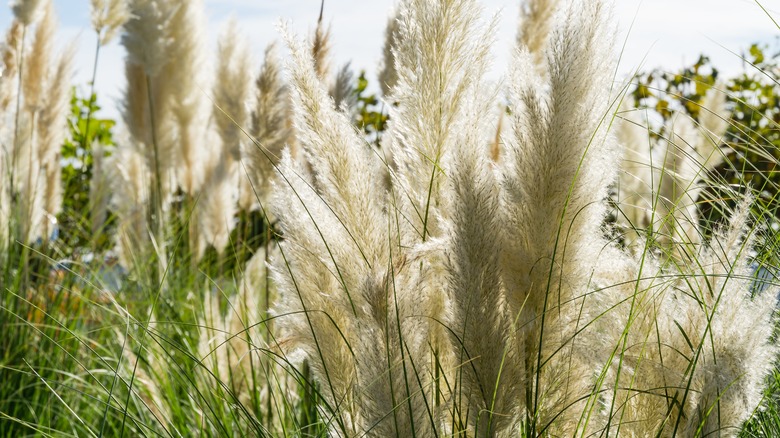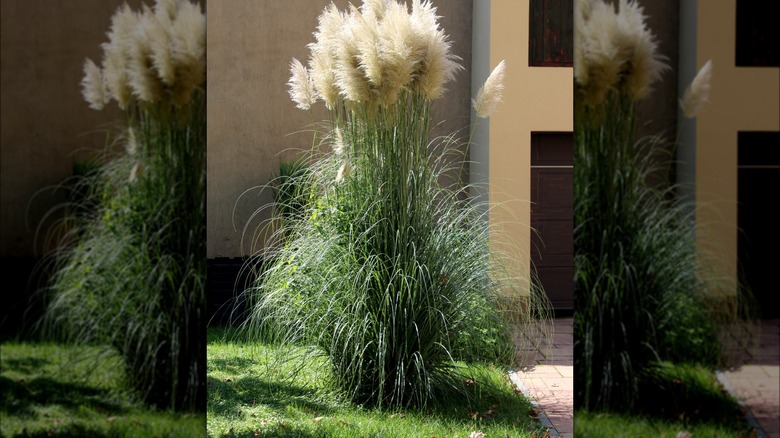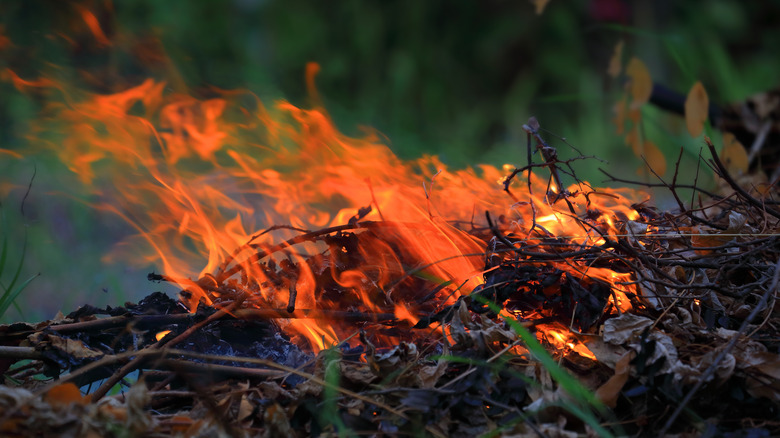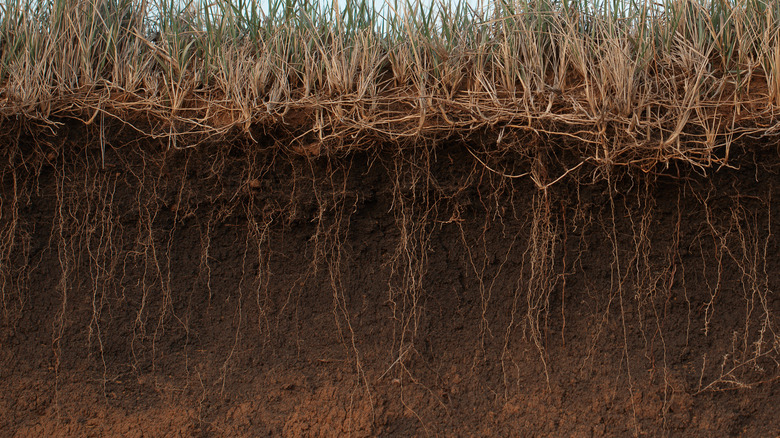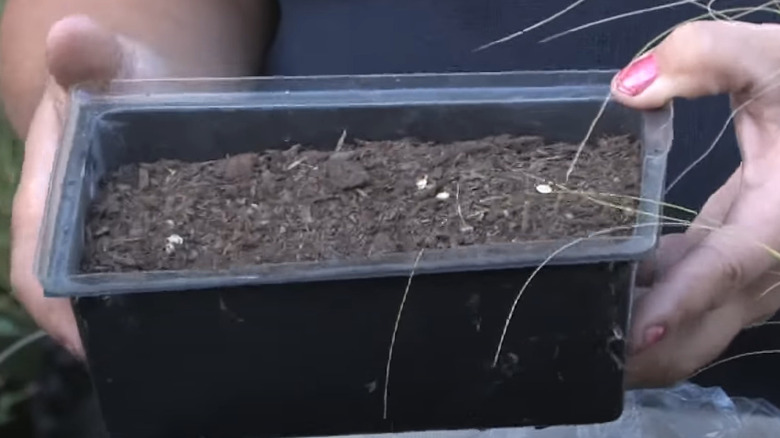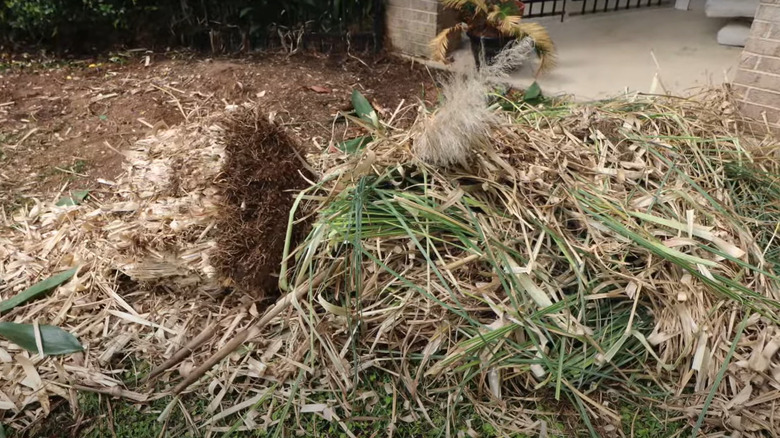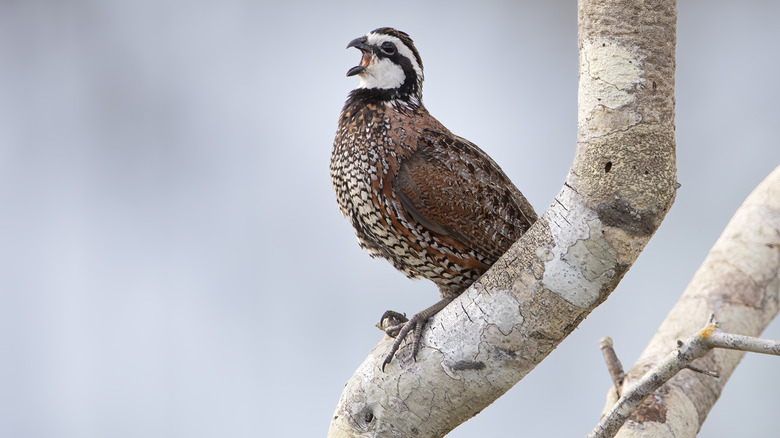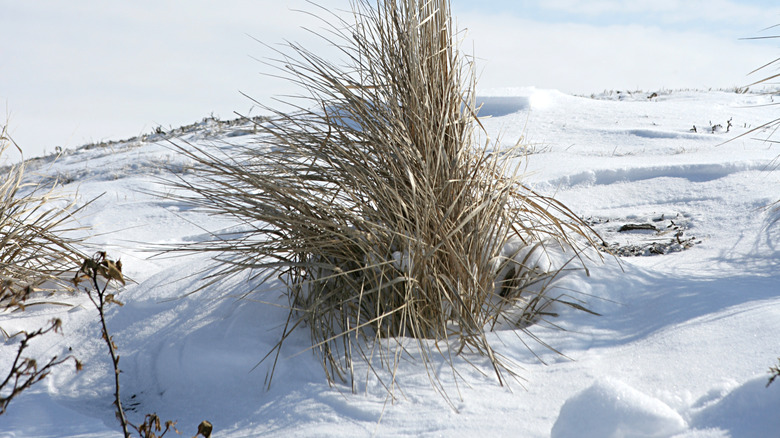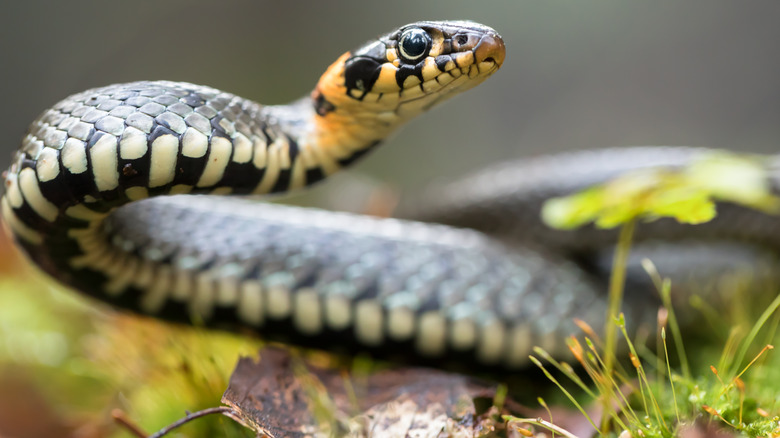10 Reasons Why Planting Pampas Grass Can Be A Huge Mistake
With homeowners tiring of monolithic green lawns, colorful, ornamental grasses like pampas grass (Cortaderia selloana) are finally seeing the (sun)light of the day. Birthing slender, pearly white fluffy plumes that sometimes blush pink or silver over bronzing, green, weeping tussocks (clumps), these magnificent, textural grasses stand tall as specimens or overstory, perennial backgrounds. So regal is their beauty that scores of interior designers and celebs have them adorning their spaces as floral arrangements, showpieces, or wedding décor! In addition to their visual interest, they're appreciated by many gardeners for being low maintenance. Plus, they hold up remarkably well on eroding slopes while staying drought-, deer-, salt-, and pest-resistant.
Yet, all these positive attributes also establish grounds for their invasiveness. After all, a non-native, hardy perennial that has no qualms about settling in a foreign territory without special assistance is likely to escape and naturalize in areas where it's unwelcome. Unfortunately, it's done just that, not only in some US states but also in countries like Australia and New Zealand. The cons don't stop at that—pampas present a fire hazard, lower biodiversity value, allergic reactions, and lots more, as we discover below.
Displays aggressive spreading, displacing native plants
Homing in with its lookalike, jubata grass, in Washington State's Class C noxious weed bracket, pampas grass is just as notorious for its voracious appetite in sunny California, Florida, Hawaii, and Oregon while receiving a free pass in the southeast. The US Forest Service's Dr. James Miller elaborates, "These plants are extremely invasive in semiarid regions after they enter drainages, but have less invasive potential in the forested east." This gluttonous spreading is concerning as the exotic plant competes with and ultimately shoulders out the native vegetation, creating a pampas monoculture. Indeed, a single plant's roots can commandeer around 1,100 square feet of underground space.
But what makes them so weedy? Pampa plants produce an average of over 400,000 seeds in their lifetime, sometimes going as high as around 840,000. These dry, 1 to 3-millimeter-long superlight kernels hop on the wind (or on humans) to reach areas 20 miles away. Since soils, temperatures, and drainage are no bar, they put down roots wherever they land, taking over roadsides, coastal wetlands, dunes, forests, or other riparian land. 2007's Okada et al. study proves that escaped Californian pampas have originated from local landscapes due to cross-pollination or dense planting. Sadly, planting sterile varieties isn't helpful either, as evidenced by UC Davis' Marie Jasieniuk's research. So, in non-invasive areas, stick to growing female pampas grasses—preferably in raised beds or pots, or cut all plumes before they seed.
Highly combustible, becoming a fire hazard
Granted, pampa grasses make gorgeous privacy screens and hedges with their silvery plumages that stand over 6 feet tall. But the taller they are, the higher the fuel load they represent. These ornamental grasses become highly flammable when they dry out, especially during the hot summer months. Their densely-packed mass plantings, along with the accumulated dead flower and foliage litter, instantly turn any yard into a fuel bed waiting to catch fire. To put it into perspective, California spends nearly $82 million per year (via USDA Agricultural Research Service) controlling damage from invasive plants and pampa grasses, which play a key role.
Unlike native plants that combust only when the drought barometer is dialed up to the maximum, exotic plants turn incendiary in diverse environmental conditions. Unluckily, their fires are highly intense, too, taking over canopies, in sharp contrast to moderate, surface-level damage for native fires. To make matters worse, these weedy colonizers resprout rapidly while depriving native vegetation's chance to recuperate. Willows and sycamores are known to have a hard time recovering from such wildfires. That's why gardeners must steer clear of pampas in areas prone to bushfires, instead opting for indigenous varieties like deer grass and white awn muhly that are equally pretty. As for other areas, pampas grasses ought to be grown sufficiently away from hardscaping elements like fire pits or cooking spots as well as the foundation, especially considering global warming is all set to aggravate the risk.
Requires protection while handling
If plants could shout out slogans, "touch-me-if-you-dare" would be pampas grass's refrain. While their tall, variegated plumages are a sight to behold and soft to touch, the same can't be said about their glaucous foliage—if their lance-like contouring is any indication. Pampa grass's drooping blades are razor-sharp through and through, with exceptionally serrated margins known to cut deep into the skin. This makes them nonstarters along walkways, pavements, or any recreational spaces that foresee high traffic. They're also unsafe around kids whose curiosity gets the better of them. There's also some anecdotal evidence about pets hurting their throats after chomping on pampas' leaves.
But even if you manage the placement, you'll face trouble when it's time to prune the grass or the adjoining vegetation, as the incisive leaves are hard to work with. At such times, wear long-sleeved shirts and protective leather gloves. To make things easier, consider tying up the clumps with a bungee cord to contain their spread before you shear or lop them off.
Alters the soil profile
While proposing the classification of pampas grass as a noxious weed, the Washington State Weed Control Board also expressed that the exotic beauty can disrupt the native soil's composition, especially lowering nitrogen concentration. They based such claims on a 2006 study conducted by Domènech et al., tasked with studying the effects of Cortaderia selloana's takeover of the local ecosystem. Although the research was conducted in Spanish pastures, the results are relevant since these grasses are flagged as invasive there, too, given the aggressive spreading and lack of any major commonalities with their indigenous vegetation.
Per the study, the areas invaded by pampas grasses showed a significant fall in nitrogen levels compared to the unaffected areas. They also showed higher carbon to nitrogen levels (C/N values), perhaps owing to their larger biomass. To add to the discourse, US-based Vourlitis and Kroon's research found that these South American imports are adaptive to the soil conditions, posting vigorous growth as more nitrogen became available, explaining their persistence and weediness. In fact, a 1992 Gagil et. al. study showed how pampas absorbed the fertilizer treatment originally given to pine trees. Naturally, the lower resource availability for native plants lowers species richness and ecosystem diversity.
May not be showy if started with seed
If you belong to the tribe that prefers seeds over cuttings, you'll want some luck to truly enjoy pampa grass's gorgeousness. The reason? Pampas are gynodioecious, meaning they grow both female plants and hermaphrodite plants (having both female and male parts on the same flower). With inflorescence covered in silky hair, it's the female plants that triumphed in the beauty lottery, leaving their male counterparts gathering dust. Unfortunately, when you start with seeds, there's no definite way to differentiate between the two sexes, so there's a high probability of ending up with the not-so-pretty male flowers. What's more, they aren't true to the parent either, exhibiting high variability in color and height. That's also why Joseph Saxton, who introduced these ornamentals to California in 1848, favored vegetatively propagating only the female forms.
Interestingly, the reason pampa grasses weren't invasive in the beginning is because their mother clumps were divided and replanted. The trouble began when nurseries began using seeds, thereby introducing hermaphrodite plants into the landscape. Their male flowers began pollinating the existing female flowers, leading to their prolific intrusion. So, to avoid adding to the menace, it's best to stick to planting only female plants—they're prettier anyway.
Difficult to control and eradicate
Not only are pampa grasses invasive, but they also act like guests who refuse to leave. And that's a huge problem since they mostly lay claim to moist, populated areas. This means burning them is out of the question, as you don't want to risk starting a wildfire. But even if you could, the grass would only return with a vengeance. You can't even have them grazed over, as not many animals find them palatable—even deer who eat just about anything, won't be tempted by this plant.
You might have a chance of getting rid of pampas grass with weeding, but be ready for quite a bit of labor and protective equipment. However, specialized gardening tools, such as long-bladed shovels or a mattock, are necessary to clear out larger plantings. But then, you must ensure no root fragments, especially the top roots and the crown, are left underground, as a little water will have them resprouting in no time. For a sure shot at eradication, it's best to dig the entire clump out. Also, mature inflorescences can be a bother, as they produce thousands of seeds that spread far and wide while remaining viable for roughly nine to 12 months. Even immature stalks spell doom as they can mature and produce seeds. When such controls fail, chemical treatments are the lone option.
Lowers wildlife value
Even though the debate about choosing between native and non-native plants remains nuanced, one unquestionable fact remains that most "native wildlife" has co-evolved with indigenous plants. This means that bees, butterflies, insects, birds, and other pollinators are heavily dependent on the native plants for survival, and by extension, so are we, as who else would pollinate the flowers in our garden and crops in the farmland? But when pampas grasses take over any area, they do so at the cost of native vegetation, jeopardizing the survival of many. Reverend Paul Rooney from Liverpool Hope University also warned, "It can be a very serious threat to native wildlife" in his interview with WalesOnline.
The problem only gets worse as diverse natives keep getting displaced, lowering the ecological diversity as a whole. Besides, even if the local wildlife wanted to adapt to the invasive grass, the chances are minimal at best since most find the dry leaf blades revolting. A USDA report cites a Lambrinos, 2006 study which found foraging animals like sheep and goats rarely chewed on pampas grasses.
Triggers allergies
Pampas grass' insidiousness isn't limited to the loss of biodiversity. It poses a risk to human health, too. Like plenty of its brethren, these perennials release copious amounts of pollen into the air to promote pollination. This wind-blown pollen triggers an allergic reaction in gardeners, instigating bouts of coughing, sneezing, and sniffling. It may also cause eye irritation. It's also known to aggravate pre-existing health conditions like hay fever and asthma. Add to that, brushing past the piercing foliage doesn't merely end in cuts; it has the potential to induce the formation of inflammatory rashes and welts.
A study conducted in 2021 by Rodríguez et al. delves deeper into the pampas grass's allergenicity property. According to the authors, while this decorative grass stands at par with native grasses in terms of prompting allergic reactions, its effects last longer. The logic is that the exotic species flowers late into the blooming season, delaying its pollen release. This amounts to the grass-related allergic season lasting almost three months, which can be quite restrictive for those sensitive to such a phenomenon.
Poor fit for some gardens
Unless you're planting Uruguayan pampas grasses for the very reasons they were initially introduced back in 1848—as hedges or windbreaks—they're unlikely to be a good fit for most yards. As august specimens that spread between 4 and 7 feet wide, these plants require a lot of room to grow and present a considerable risk of extending into your neighbor's yard. Moreover, reaching almost 6 to 12 feet high, they're generally considered too tall for most places, especially given how they may overshadow your flowering annuals. Although some choose to plant their dwarf varieties, they too reach around 5 feet in height. However, the height becomes a non-issue if the point is to cover up gardening equipment or HVAC units.
Additionally, pampas grasses may be a poor call for those looking for winter interest. Although this non-native species is considered hardy from zones 6 to 8, it begins to squander its evergreen quality when temperatures dip below 10 degrees Fahrenheit, dying back completely when frost hits. However, varieties like Patagonia, Andes Silver, and Pumila may survive the cold climates.
Harbors vermin
There's more to pampas grass's notoriety: they shelter vermin while forcing out the beneficial wildlife. In fact, they're a popular landscaping plant where snakes love to hide. And that makes sense. These ornamentals are sufficiently tall and thick for snakes to slither around unnoticed. This lends them adequate protection against their chief predators, including owls and hawks, and any prying human eyes, although "who's scared of whom" is up for debate. Some residents have also reported seeing rats burrowing deep into these dense mats. These, along with other tiny critters hiding in these grasses, further serve as draws for snakes.
That being said, eliminating food sources can minimize the pest menace—after all, they require the trio of food, water, and shelter to survive. Pruning the foliage 6 to 8 inches above ground can also help repel pests from your garden.
